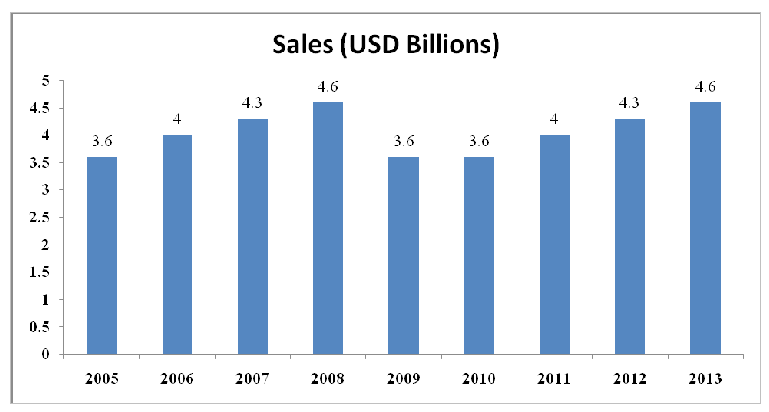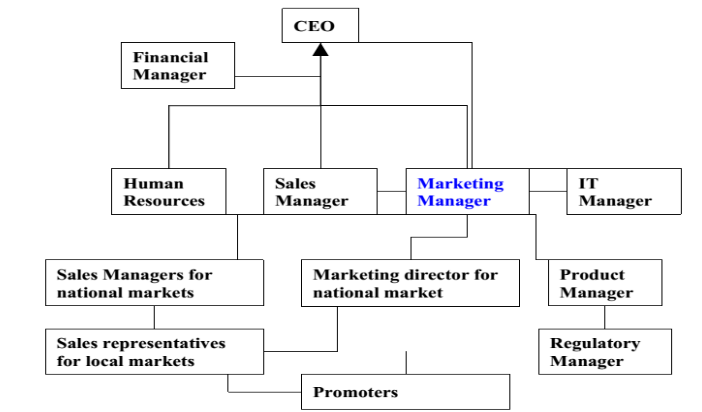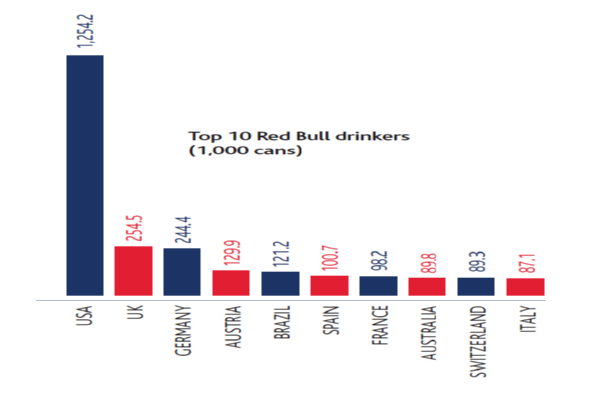
Table of Contents
Introduction
SWOT Analysis of the Red Bull GbmH Company
Introduction
In achieving success of a business entity, a marketing strategy is necessary. The company’s marketing plan forms the business plan and is a drive for achieving the company’s goals and objectives in any business. Manufactured by the Red Bull GmbH Company located in Austria, Redbull has become a popular drink in the world with a wide market share. Produced from the idea borrowed from a Thailand energy boost drink, Krating Daeng, Dietrich Mateschitz, an Austrian entrepreneur modified the ingredients of the original drink to suit Western markets. The Red Bull GmbH Company was founded in 1987 (Baltes & Leibing, 2008). The business has since then developed to become a global dispenser through their advertisements, events, sports team ownership, celebrity endorsements, and music promotions. The global market has brought to play a number of large soft drink companies like Coke and Pepsi, and other emerging companies that pose a challenge to the Red Bull Company. Therefore, the current paper profiles the Red Bull Company with an emphasis on the marketing techniques that help it survive in the global market.
Vision/Mission
Red Bull is committed to upholding Red Bull standards, while at the same time being the industry leader in the energy drinks sector when delivering better quality service in a manner that is profitable and efficient. The company also strives to develop a culture characterized by employees sharing the best practices with regard to coaching and developing the company as an employer (RedBull, n.d.).
History
Since its foundation in the year of 1987, Red Bull has had a successful turnout in the energy drinks market with large returns in terms of sales. In the 1990s, Red Bull expanded and introduced its products to neighboring countries like Hungary, Slovenia, Germany and the United Kingdom. In 1997, Red Bull was introduced in the United States as a non-corporate alternative to Coke and Pepsi. The company’s entrance into the United Sates was accomplished through California as the first state to be supplied with its products. The packaging and prices per can were a boosting factor towards the increased market demand compared to Coke and Pepsi. According to RedBull (n.d.), by the end of 1999, Red Bull was being sold in more than 50 countries with a probable sale of about 600 million to one billion cans worldwide. In spreading its impact into the global markets, Red Bull associated itself with a number of promotional activities aimed at generating revenue and providing an opportunity to venture into new markets. The Red Bull Company supported a nascent extreme sports movement, where it sponsored snowboarding and free skiing. Additionally, the company promoted the beverages distributed among its target markets with the slogan, ‘Red Bull gives you wings.’ With the youth’s conviction of the energy boost that the drink provides, the increased sales in the United States were realized. Animated TV advertisements that were used in the matured markets also played a role in the continued expansion of Red Bull (RedBull, n.d.).
In 2001, the products of Red Bull were shipped to South Africa and Brazil as the new markets for the business. Despite the challenges from the side of its competitors, there was a revolutionary result of the Red Bull energy drink in acquisition of the already established markets for its competitors. In 2002, regional headquarters of Red Bull were opened in Dubai. In 2003, however, the Red Bull Company produced their first sugar free drink that was aimed to increase its market segment (RedBull, n.d.). The increased market share of the Red Bull product saw a reflection in the upward sales in 2008, when the previous ban of its sale in France, Denmark, and Norway was lifted. As of 2013, Red Bull enjoyed a market share of all the 27 member states in the European Union and additional 165 countries of the world.
You can ask us “write my research paper” on this or any other topic at Essay-Online-Shop.com. Don’t waste your time, order now!

Products
Red Bull Company specializes in the production of energy drinks. With a wide market to satisfy, the company produces a range of energy drinks fulfilling the needs of its customers. The products include Red Bull energy drink, Red Bull total zero, Red Bull Sugar free, the Red Bull editions (silver, red, and blue), and the Red Bull Cola. The Red Bull energy drink is meant to vitalize the body and mind. Top athletes, professionals, students, and travelers on long distance journeys drink Red Bull to increase their concentration and focus. Additionally, the energy drink can be consumed before and after the performance and at any other time that requires increased mental application. First manufactured in the year of 1987, the Red Bull energy drink is the first product the Red Bull Company has ever manufactured (RedBull, n.d.).
The Red Bull sugar-free drink entered the market in the year of 2003. The sugar free drink belongs to the variety of the Red Bull products that are produced without sugar components. In the production of the Red Bull sugar free drinks, sucrose and glucose components have been replaced with Aspartame and Acesulfame K as sweeteners. The production of the sugar free drink was a competitive strategy for a segment of the customers in the business. Following the trend set by the Red Bull Company, soft-drink companies have also produced sugar free drinks for the market. Another product of the Red Bull Company is a total zero drink introduced to the market in 2005. The total zero drink ingredients contain no calories, sugar and carbohydrates; hence the name is total zero. However, in their production, such sweeteners as Acesulfame K, Aspartame, and Sucralose are included as part of the ingredients. The Red Bull editions (silver, red, and blue) contain the cranberry, blueberry, and lime flavors respectively. The Red Bull editions came to market in the year of 2013, in the selected United States markets (RedBull, n.d.).
Another product of the Red Bull Company that had no influential impact in the market is the Red Bull Cola. Introduced in 2008, Red Bull Cola was intended to be sodas drink as a counter marketing strategy to acquiring more customers compared to the company’s competitors. However, close re-examination of the drink by the health organizations in different countries such as Germany identified traces of Cocaine in its ingredients. Nonetheless, the ingredients used in the production of the Red Bull Cola has been determined to be of a small amount that could not have the effects of cocaine on the consumer. Compared to the other business entities, Red Bull displays a less aggressive business approach by its maintaining the packaging of its products except for a small change in the brands of the cans. Except for the new Red Bull editions that have been adjustments in color and design of the bull, the Red Bull products contain the same ingredients and the slim line cans for the packaging. However, in the already established business centers like the United Kingdom, the company has introduced one-liter PET bottles.
One can of the Red Bull drink contains 80 mg of Caffeine, Taurine, Glucoronolactone, sugars, and vitamins. Taurine is a unique ingredient that the Red Bull Company considers their essential component in the manufacturing of Red Bull drinks. In the organic body, taurine is extracted from the bile of a bull. The extraction and components of the taurine have been a topic of interest with many arguing that it is extracted from bulls’ testes or contains the semen of a bull. However, the Red Bull Company produces their product with the taurine ingredient existing in a synthetic form. Other components include caffeine used for its stimulating effects on human activity. B-group vitamins are also used to maintain a healthy body function. The drink also contains sucrose and glucose except for the sugar free drink that is absent. The sucrose and glucose are aimed to supply vigor to the body and brain of the user; thus, increasing their concentration. The last part is water that is used as a mixture for all the ingredients (RedBull, n.d.).
Few but rare cases of the negative effects that Red Bull causes to the consumers occur. However, the real scientific explanation is not provided as to the effects that Red Bull might have on a patient. One of the cases is the Ross Cooney story who collapsed and died on the court after consuming fours cans of Red Bull. However, his death was later concluded to be due to the SADS (Sudden Arrhythmia Death Syndrome). Due to the health concerns, many countries such as France, Norway, and Denmark banned the sale of Red Bull within their territories. Norway, for example, made it clear that Red Bull was a drug and its sale was not to continue in the retail outlets. The controversial discussion on the effects of Taurine and Glucoronolactone used in the production of Red Bull was of concern in many countries. Consequently, the distribution of Red Bull was prohibited in many countries that believed Red Bull had side effects on consumers. The law was the biggest setback in the globalization and business expansion of the Red Bull Company. The ban on selling the Red Bull products was later on lifted with scientific results that proved health safety concerning consuming Red Bull drinks.
Revenues
To increase the returns for the business from the sales and other associated activities, the Red Bull Company operates in many other businesses apart from the energy drinks industry. Red Bull owns and manages a construction company, football clubs, youth academies, and TV broadcasting. Additionally, the company has a medium’s service that produces magazines on football, motor racing, celebrities, and lifestyle magazines (Bodner, 2011). As of 2013, the total sales of cans from the Red Bull Company were estimated to be $35 billion since the first sales from the company reached the market. The analysis of the company’s revenues as from 2005 to 2013 gives increasing sales in the business with 2009 and 2010 recording the least sales. However, in the preceding years, the revenues have been stabilized to $4 billion.

Figure 1. Sales revenue for Red Bull 2005-2013.
The table above reflects the total revenues per year from 2005 to 2013 with the main products of the Red Bull Company. Additional revenues from investments and segments within the business like online events and advertising accrued over 1 billion US dollars in 2013 compared to $878 million realized in 2012 that reflect the total revenues the company achieved. The specialty retail stores managed by Red Bull contributed 77.8% of the total revenues achieved in 2013. The totals reflect a reduction in the sales compared to the preceding years, which saw 2012 having 79.78%, 2011 having 81.08%, and 2010 recording 81.53%. With more than 15,000 employees as for the 2013 rate, Red Bull has managed to make effective sales and returns from different investments that it operates (RedBull, n.d.).
Top Management
The Chief Executive Officer, who works in co-ordination with the financial manager, human resource manager, sales manager, marketing manager, and IT manager, runs the organizational process of the company. Under their supervision, there are the national business managers for the sales and marketing and the product manager (RedBull, n.d.). The regional offices and branches of the main business have regional managers who are answerable to the top management. Under the supervision of the human resources department and sales manager, there are the sales managers in charge of the national markets and sales representatives responsible for the local markets. The marketing manager, however, works with the IT manager, promoters, and sales representatives of different markets.

Figure 2. Organizational structure of Red Bull.
Competitors
Red Bull faces a high competition in the energy drinks market with the increased number of energy drinks companies that have secured market shares. In terms of performance and the sponsorship programs that the company invests in, there has been a great success and returns for the markets’ continued growth. However, the global market presents 100 competitor companies that deal with energy drinks. The most commonly known are the Coca-Cola Company, Pepsi, Rockstar, Burn, Gatorade, and the Monster Beverage Co. The music industry has also brought competition to the market energy drinks such as Liquid Ice and Nelly’s Pimp Juice, which are a great challenge in terms of the markets that Red Bull has secured both locally and globally. The Coca-Cola Company is the biggest competitor and presents many challenges so that Red Bull might spend a lot of time before achieving their status. The Coca-Cola Company enjoys popularity as it has been introduced long before Red Bull (Baltes & Leibing, 2008).
Additionally, the Coca-Cola Company has a good financial system and better marketing strategies compared to Red Bull, which makes it a giant in the supply and the amount of products that are out to the markets. The Coca-Cola Company also enjoys customer loyalty that they have acquired in the global market and local markets, making it hard for Red Bull to acquire the desired market share. Compared to the number of countries that Coca-Cola and Red Bull serve, the Coca-Cola Company has over 200 countries that it serves compared to Red Bull that still has 161 countries where its products can get a market share. Looking into the marketing principles for Coca-Cola and their success in the business, Coca-Cola uses a set of principles that creates an impossible marketing condition for Red Bull. Firstly, Coca-Cola operates in the guerrilla marketing strategy (low cost/no cost method), the carpet-bombing design (mostly the use of flyers, which are most effective in creating awareness), referral networks, and the Internet as it has major systems to reach out to the target market (Brasel & Gips, 2011; Keller, 2008).
Pepsi Co. has also been a major competitor of Red Bull in the sale of energy drinks. In marketing their products, Pepsi created a sampling and sponsorship strategy, which was similar to the ones organized by Red Bull. In targeting the young generation, Pepsi employed young sales agents that could easily interact with their age mates and convince them to buy their products. Additionally, Pepsi was offering free drink samples in the campuses and provided support to emerging music events and artists. However, every business Red Bull ventures into has a number of competitors. In the United States, Nestle adds to the other small competitive companies and Coca-Cola as the competitors that Red Bull shares the same market with. In Europe, small retailers and companies as Ansheuser-Bush, Euro Food Slovakia, and TECFOOD collectively are the companies that are competitive for the Red Bull products (Zenith International, 2004). The Let’s Go, a product of the Euro Food Slovakia comes in the flavors of orange, grapefruit and black currant flavors with guarana instead of taurine that Red Bull uses as their main ingredient. To increase further their market shares, the Euro Food Slovakia releases their products at a cheaper price compared to Red Bull products. Additionally, Euro Food Slovakia creates awareness through their website encouraging their consumers to mix a drink with alcohol with no health issues.
Another competitor of Red Bull is Czech glass, Kamikaze, which targets the young generation and party attendees. With its uniqueness in such ingredients as Bull grass, Hemp seed, Chili, Cactus fig, and tribulus terrestris as a stimulator, the Kamikaze drink poses a threat to the market segment of Red Bull. Anheuser-Bush Inc. founded and located in Austria, is among the biggest competitors of Red Bull. Originally founded to promote alcoholic beverages only, Anheuser-Bush Inc. has ventured into the energy drinks industry considering the success of Red Bull since its founding. With the large market that it initially has created while promoting alcoholic drinks, Anheuser-Bush Inc. poses a challenge to Red Bull in the number of customers. Anheuser-Bush Inc. new product, 180 was released in the market with a combined effort of Pepsi. The marketing of the 180 product is meant to help boost the knowledge of the products compared to Red Bull. However, even with the small changes in the ingredients used in the manufacture of energy drinks, Red Bull has managed to maintain its position in the market and simultaneously, increase its impact in the global markets (Gorse, Chadwick, & Burton, 2010; Pride & Ferrell, 2008).
Red Bull had an advantage of being the first to introduce the energy drinks in most markets and as a result, had a significant impact in the number of customers and prominence. By building awareness through seeding and relying on word-of-mouth approach, the company can reach the target markets and maintain an influential place in the energy drinks industry. In markets that had already been entered, like Brazil, the image perceptions and customer loyalty had to be overcome in terms of the prices of the initial products and the customers’ preferences. Once Red Bull accomplished a volume prowess against its competitors, they sought to ensure that its competitors had reduced their prices. According to the Zenith International (2004), Red Bull had two-thirds of the market share of the energy drinks in Western Europe. Additionally, among 13 Western Europe countries, Red Bull had established dominance over 12 countries. The competitors, however, had 17 per cent market share (Fullerton & Merz, 2008).
- FREE revision (within 2 days)
- FREE title page
- FREE bibliography
- FREE outline (on request)
- FREE e-mail delivery
- FREE formatting
- Quality research and writing
- 24/7/365 Live support
- MA, BA, and PhD degree writers
- 100% Confidentiality
- No hidden charges
- No AI-written content
- Complete Authenticity
- 12 pt. Times New Roman
- Double-spaced/Single-spaced papers
- 1 inch margins
- Any citation style
- Up-to-date sources only
- Fully referenced papers
Countries that Sell Red Bull
Red Bull has established a global business with 164 countries selling its products (RedBull, n.d.). The Red Bull Company has two production sites that are Austria and Switzerland.

Figure 3. List of top 10 countries consuming Red Bull.
The United States, being the highest consumer and distributor, has been a platform through which Red Bull has increased its power in other countries. Owing to the high affiliation that countries in the world have attached to the United States, high returns realized from the selling of Red Bull are also presented to the foreigners while visiting.
Marketing Philosophies
Red Bull applies a number of principles in marketing its products and acquiring customers. With the competitive forces in the local and global markets, Red Bull has devised philosophies that supplement their business strategy and objectives in attaining success in business and markets. First, Red Bull has spread its brand and products by applying the oldest media form, word of mouth. Started in Austria, few people knew about the energy drink Red Bull was manufacturing. Being part of the business segment meant that they too were to be informed and considering the technological advancements at that time, the only way through which more customers could get to know about their products was through spreading the news through customers. With an effective strategy and communication process, many of their consumers had an understanding of what the company was supplying them. This process was a successful market entry strategy for Red Bull, and is still an effective method in acquiring new business areas and the competitor dominant sectors of the business.
Second, Red Bull created a mystique for their brand as a method of targeting the adventurous consumers in the markets. At the bars and clubs, cans of Red Bull were introduced to attract the customers who were in for trying new business products. Therefore, combined with the information the customers had heard before about the new product in the market, they would want to taste what Red Bull offered compared to the other drinks. As a supplement of word-of-mouth strategy, developing a mystique for the Red Bull brand proved to encompass a greater deal of business sections. Consequently, the brand was on demand in the neighboring countries following the news passed about Red Bull.
Third, Red Bull operates with a well-formulated market entry strategy, ‘Seeding Program.’ With an identified target in any market segment, such as the young generation, party revelers or the adult, Red Bull uses the result that shops, supermarkets, retailers, clubs, and bars have created for their customers as their entry points (RedBull, n.d.). Lastly, Red Bull also applies ‘pre-marketing’ strategies aimed at creating awareness in the new markets that they are entering. Therefore, before making the first supplies of their products in any market, Red Bull encourages awareness among its customers as for the promotional events that are a platform of getting a large audience at once.
Marketing Activities
Awareness, marketing, and business position in the market for the Red Bull Company are attributed to the activities and promotions that Red Bull operates in selling its products. Advertisements are the first marketing activities that Red Bull associates to encourage awareness and sell its products to its customers. The company logo is placed on every product that Red Bull sponsors. The advancements in technology have also seen the increased publication with the social sites like Facebook and Twitter. With over 36 million fans on the social media sites, Red Bull is ranked among the top 10 liked corporations. The fan page is a promotional site for the events and products associated with the business.
Red Bull associates with its customers through the sampling method, which aims at identifying the target group and providing their products at the time of interaction. Thus, at concerts, parties, festivals, sports events, or the campus grounds, the Red Bull Company can conduct a survey to get statistics of the extent to which their influence on the consumers has been increased in terms of product supply and use. This sampled result forms the consumer statistics that is later on used to calculate the impact of the business on consumers and the areas of the market that require emphasis in terms of promotion and awareness. Sampling is a market approach employed by the Red Bull Company and accomplished by a professional group of employees within the company, whose goal is to identify customers who are exhausted or tired and give them the energy drink to regain their strength. This random promotional strategy aims to increase the knowledge of the public on the positive effects that Red Bull has as an energy source. Additionally, Red Bull is renowned for its effectiveness in event marketing strategies. The events organized by Red Bull are a platform for the business to make sales and at the same time, support its growth with wide knowledge. With their financial and personnel support, Red Bull hosts mountain biking, BMX, motocross, rally, Formula 1 racing, snowboarding, skateboarding, kayaking, wakeboarding, cliff-diving, and freestyle motocross. The company also supports music events, which support the dance crews and artists in selling the company’s products (RedBull, n.d.).
Red Bull sponsors football teams that are required to have the company’s trademark logo on the uniforms. In the gaming platform, Red Bull has developed its own game island that advertises the company’s energy drink and the Air Race event that is sponsored by Red Bull. The company also has a motorsport circuit (found in Spielberg, Styria and Austria), a football stadium (for the RB Leipzig German football club), an American football stadium (for the New York Red Bulls club) and a multifunctional building, in which the company hosts a collection of historic airplanes. The company identifies icons, idols or famous sportsmen within the society and contributes to their training, equipments, and social publicity. As the company invests in sponsorship programs for these athletes, the athletes in turn are used as models for the promotion of the company’s products.
Red Bull has also invested in the media and TV shows as a secondary way of creating awareness among its customers. The Red Bull’s commercials displaying real life situations have had a high impact on the life of consumers. The commercials aim to present to the customers how Red Bull ‘gives one wings’ to fly over the hard situation. The Events sponsored and organized by Red Bull have also been recorded and can be accessed at various stores. The company has a website that allows people to view their events and the time they are to take place. To increase its media coverage, Red Bull monthly produces magazines, such as the Bull’s Eye. The magazine compiles the events, location of the events, and the athletes that are to participate in the events. In addition, the magazines outline news and important messages that are relayed from the top management of the Red Bull Company and the headquarters staff members (Keller, 2008).
SWOT Analysis of the Red Bull GbmH Company
SWOT (Strengths, Weaknesses, Opportunities, and Threats) relates to a structured planning approach used for the evaluation and identification of a company’s internal and external factors that may be favorable or unfavorable with regard to achieving its objectives (Keller, 2008).
Strengths
The strengths of the Red Bull Company are dependent on the company’s leadership, marketing efforts, and the Cadbury Schweppes alliance. In the energy drinks industry, the Red Bull company is the leader owing to its promotional events, well-targeted campaigns and the sponsorship programs that the company takes part in. The annual company’s sales are approximated to be a billion in every financial year with the leading markets being the United States and Europe. The UK market provides an 80% market share for the business. In Europe, the Red Bull Company accounts for two thirds of the energy drinks sold. The market trends of the Red Bull Company are in favor due to the reduced number of new arrivals as compared to when the company first occupied a market position. Consequently, the emerging products are facing the challenge of making the business impact compared to the already established business of the Red Bull Company. The Red Bull Company has strong marketing philosophies with a target market of the age group of 18-25. The interactive marketing trends create high impact on the returns that the Red Bull Company realizes at the end of the financial years (Fullerton & Merz, 2008). The company’s brand has also been an advantageous point to the continued growth of the business. The young generation associates with the Red Bull products with the result that they believe the company provides for them by offering their product. The sponsorship and the events that the Red Bull Company takes part in is a platform that has helped the company increase its impact in many parts of the world. Partnership with companies like the Cadbury Schweppes in Australia has enlarged the territory of power for the Red Bull Company (Bodner, 2011). In addition, Red Bull draws its strength from being a market leader. Red Bull boasts of 70 percent market share globally in the energy drinks sector (Fullerton & Merz, 2008).
Other strong points that the Red Bull Company enjoys in the sale of its products include a good reputation among its consumers and the other competitor companies; the company has a strong brand equity and financial position. Moreover, the products that the Red Bull Company produces are unique compared to the similar products that other companies try to produce. The copycats of the business have not had a chance to enjoy the market share that Red Bull enjoys in the market. Communication is a vital element in attaining success in any business entity. The communication system of the Red Bull Company is considered a priority in the management of the headquarters offices and regional offices that are situated in the different countries where the company has opened its branches. Red Bull ranks 79th among the global ranks that are worth at least $8.154 billion, and ranks 4th among the most popular soft drinks brand behind Coke (Diets, Lights and Zero), Coca Cola and Pepsi (Brasel & Gips, 2011).
Weaknesses
Red Bull Company has maintained its original product with few innovations and diversification strategies in the products they release to the customers. Apart from the energy drink, the Red Bull Company has the sugar free, and the Red Bull editions that are of different flavors. However, new entry companies use this to their advantage by producing a wide variety of products, which could rob the Red Bull Company of its customers if one of the rival companies came up with products that best suited the customers’ needs. Despite the fact that the company has attempted to diversify its product portfolio, Red Bull is still susceptible to fluctuations in the market (Keller, 2008).
The production of a particular product for their markets creates a vulnerability point that could result in losses for the business of the Red Bull Company, if there was to be a change in the market trends. The reliance on a single product as the main revenue generator for the company makes the company develop a weak point in serving its customers from different market regions; as a result, these market forces could change at any time. Compared to the other companies in the energy drinks market, Red Bull’s products are considered expensive. Despite the high returns that the prices have at the end of the financial years and the sales in various markets, it is also a weak point that the competitor companies might use to their advantage. If one of the competitor companies releases a substitute product into the market at a lower price compared to the prices that Red Bull sells its products at, then the company might lose its place in the markets it dominates. The Red Bull Company has a single manufacturing plant in Austria (Gorse, Chadwick, & Burton, 2010). However, the market demands in the ever-increasing global market poses a threat to expect more production than usually. Inadequate supply of products and services affects the business purpose of meeting the demands of the markets in supplying them with the energy drinks (Bodner, 2011).
Opportunities
Vending has been a strong marketing technique for companies like Coca-Cola and Pepsi in the diversification of their products and reaching customers. The adaptation of the technique to the marketing activities of the Red Bull Company will help the company reach out to many customers and still create a large market share. With a large global business, the Red Bull Company has an opportunity to tap more of the resources that it could get from different markets. Alternatively, the Red Bull Company can also venture into new markets that its competitors have not had high impact on. Apart from the Coca-Cola Company that might be having a large business result in the whole world, the number of countries that Red Bull supplies its products could be a starting point to developing its result (Brasel & Gips, 2011).
Threats
The slow growth of the company’s impact and returns in the different markets poses a threat to the future of the business. As the markets mature, the company share in the market continues to dwindle that is caused by the consumer’s inquiries and loss of knowledge of the business among the customers. Emergence of bottled water with the knowledge that has grown regarding the health benefits that it has to the users is a threat to the sale of Red Bull in the coming years. Despite the company’s new products like the zero sugar drink, another segment of the target market is concerned about the caffeine levels in the Red Bull products. Countries in Europe like Denmark and France uphold the laws that are against the vitamin and mineral enriched products. The restrictions are a hindrance to the increased business effect of Red Bull as it increases its global effect (Pride & Ferrell, 2008).
Future Plans
Red Bull occupies a large market share in both local and global markets; however, other competitive companies in the energy drink industry can occupy the area it dominates. The emerging companies pose a threat of coming up with better flavors of the energy drinks that might sway the customers loyal to Red Bull and as a result, Red Bull might lose its customers. Additionally, customer’s preference to the products of choice might shift making them go for a substitute or change their preference to cheaper products in the markets (Zenith International, 2004).
These factors sum up some of the areas of interest for the Red Bull Company in safeguarding its effects on their customers. Therefore, Red Bull should diversify their products in the markets to help them attract more customers compared to selling a single product. Despite the fact that the Red Bull’s business strategy is aimed to maintain the same ingredient in their drinks, not all customers’ demands are met with the current products that Red Bull offers. Innovation of business translates to the outcome that the company realizes in terms of the returns from their customers. In this respect, the market research should be done with the intention of identifying the untapped resources and areas that the company could turn its advantages to. The company should also invest in product adaptation analysis with respect to the new areas of interest that the company might want to venture. Putting into consideration the current customers, the Red Bull Company can determine the best way, by which the newly introduced products will best suit their current consumers. In the process, it will be saving on the current customers and using them to market the new products they are adding to the business (Fullerton & Merz, 2008).
A section of the market segment that the Red Bull Company targets have concerns regarding the caffeine contents in the products. The fact that there is an opportunity that the Red Bull Company can use to attract more customers can be a way of using for diversifying their products. In addition to this, the company can produce more products to target not only the customers who are in need of non-caffeine drinks. The marketing campaigns of the Red Bull Company have had a great impact on the awareness and sale of its products. However, the result is slowly diminishing owing the new brands that are introduced into the business. Customers change with respect to the changes in the market entries to get a taste of the new products. Diversification can be a counter strategy that Red Bull can apply for ensuring that when the new companies are introducing their products into the markets, they too have products that they can offer to their customers (Brasel & Gips, 2011).
The advertising methods of the Red Bull Company can also be boosted to aid the company in maintaining its power in the markets that it serves. Tools like advertisement banners, postcards, posters, and contact with the customers on the ground serve as the best methods, through which the Red Bull Company can rejuvenate its result in the markets it serves. The Internet is a powerful platform, with the help of which the Red Bull Company can tap to distribute its advertisements and information among the different business areas. The Internet can be used as a way of increasing the sponsorship programs the company is engaged in and at the same time, increase its awareness among different nations that the power of Red Bull has gone down on. These form part of the areas that the Red Bull Company seeks to address in stabilizing its place in the business and at the same time, ensuring its customers are loyal to the company (Gorse, Chadwick, & Burton, 2010).
Conclusion
The Red Bull Company started its business from the development of the energy drink previously known as Krating Deng, manufactured in Thailand; it has soon grown to become a global product that is now popular all over the world. The support and sponsorship events of the company have had high impact on the establishment and development of the business in the local and global markets. The competitive companies like Coca-Cola and Pepsi play a vital role in the continuous accomplishment of the business and the emergence of other companies in the energy drink industry. With the stretch that the Red Bull Company has made in marketing its products, it is not enough to maintain their market position. The new entrants, already existing competitors, and substitute drinks create the threats that the Red Bull Company faces and is to address.






